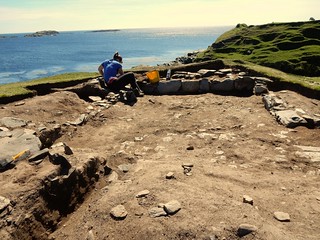Welcome to a new academic year, and to a new year of students returning from trips funded by the Nanovic Institute! To kick off the year, we would like to present Molly Seidel, a Junior majoring in Anthropology and Environmental Science. Molly traveled to Ireland last summer to participate in the Cultural Landscapes of the Irish Coast (CLIC) project, and she has a fascinating and entertaining story to tell!

Going to the field for the first time for archaeology work, I knew that I should expect the unexpected. I had traveled thousands of miles to Inishark, an abandoned island off the coast of Western Ireland, for the chance to participate in the Cultural Landscapes of the Irish Coast (CLIC) project. CLIC is a multi-year project led by Notre Dame professor Dr. Ian Kuijt that works to preserve the cultural heritage of Irish islanders, a perfect opportunity for an anthropology student like me to work with ND professors, professional archaeologists, and other undergraduates. Inhabited from the Bronze Age to the mid-20th century, Inishark is is a cultural treasure trove for archaeologists, rich with the history of Bronze Age pastoralists, Medieval monks, and hardy farmers of the 19th century. This year we were focusing on excavating a large home from the 1800s, working with historical records and oral histories of the islands to document the settlement patterns of the island.
Early in the month-long project I was relishing my newfound excavation skills by uncovering various large stones and artifacts under the layers of thick sod and dirt, but I was having a bit more trouble with interpreting what I found. I kept finding pieces of crumbly white rock near larger stones that seemed to make up a larger structure, but it must have collapsed many years ago to leave little more than a disordered pile of rocks. I was digging where a wall of the house should theoretically be, so I asked Frank, one of the professional archaeologists in the group, to take a look. Frank is literally and figuratively a giant of Irish archaeology, his six-foot-five frame slightly stooped from decades of experience digging Medieval and contemporary sites all over the country, so I knew he would be able to give me the advice I needed.
I expressed my befuddlement at what exactly I was digging, whether it really was a wall or just a pile of rocks left over from clearing fields. He knew right away what he was looking at, expert eyes quickly assembling context clues from the area, but he wanted me to think a bit more before he gave me the answer. “The clue for this spot is that white rock,”he stated in his thick Irish accent. “Once you identify it you can understand the context of this area, how the white rock relates to the other stones and features in the site.”
“How exactly do I do that?”I was stumped. I thought the crumbly stone might be a part of a wall, but had no way of being sure with so many stones laying around in disarray.
Frank chuckled at my confusion, then offered “I want you to taste it.”
I must have given Frank a look that implied my total disbelief, so he picked up a piece of the rock, brought it to his lips, and licked it to show that he wasn’t kidding me. “See? You can really taste that limey zing that tells you it’s mortar.”I laughed, shrugged, and tried tasting it myself. He was right; the powdery rock had a slight zing to it rather than the neutral taste of dirt I expected.
“And since we know that it’s mortar, that tells us that it’s holding together these larger stones to make a wall,”he said as he grabbed his own trowel, kneeled down, and started digging away. He excavated more in five minutes than I had in the past half hour, exposing more large stones and small white rocks laid out in a straight line in either direction. With new insight, I could see the places where the mortar fit between larger stones, and suddenly a defined wall of the house seemed to materialize right in front of me. Though the structure had been there the whole time, it took some expert instruction from Frank to help me see the site a little differently in order to more fully understand it.

During the month I spent in Ireland, I had many moments similar to this one as I gained various technical and analytical skills vital to archaeological field work. It is cliché to say that there are some things that you just cannot learn from a book, but I was amazed at how different and intricate archaeological practices were in the field from the lessons I had learned sitting in a classroom. I never could have gotten a feel for changes in soil gradient by just leafing through a textbook, and never could have tasted the difference between mortar and granite while sitting in a lecture hall. I also relished the chance to learn from professional archaeologists like Frank, closely observing him at work in the field to discover the proper way to hold a trowel or shovel-shave a sod wall, and listening to fascinating stories of local culture tied to the artifacts we were uncovering. My experience in Ireland showed me how archaeology is practiced in the real world, and I am so grateful to the Nanovic Institute for supporting my research and education beyond the classroom. Nanovic gave me the chance to move beyond my comfort zone and see the world in a new way, to open myself to new experiences and to explore incredible places like Inishark. This trip taught me a lot of things, but most of all I’ll always remember Frank’s advice that I shouldn't be afraid to get down and dirty by licking a few rocks.